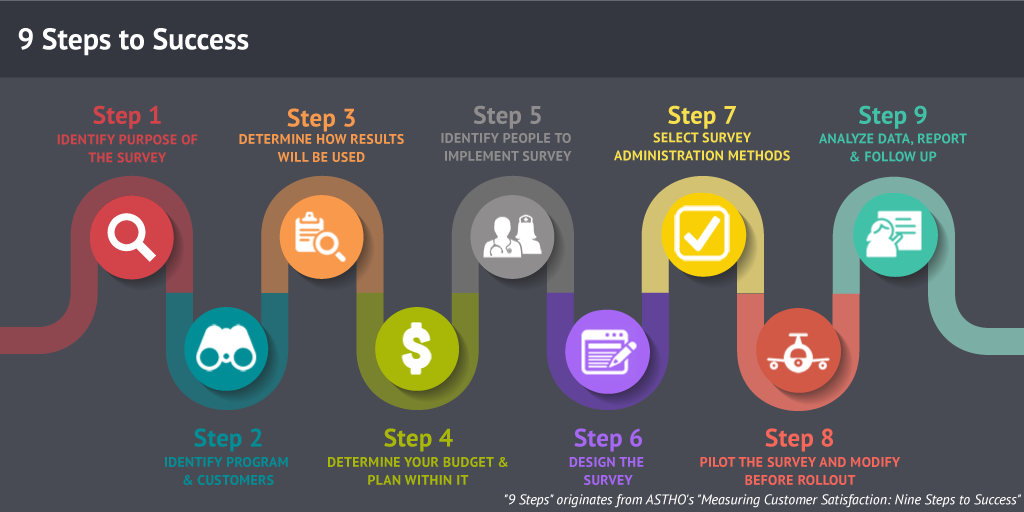 High-performing health departments continually improve by assessing the quality of programs and services and by acting on identified opportunities for improvement. Customer surveys are a common method to capture real-time information and data about the quality of programs and services from the viewpoint of those being served. If planned and executed carefully, customer surveys can capture customer feedback that can then be used to plan for improvements.
High-performing health departments continually improve by assessing the quality of programs and services and by acting on identified opportunities for improvement. Customer surveys are a common method to capture real-time information and data about the quality of programs and services from the viewpoint of those being served. If planned and executed carefully, customer surveys can capture customer feedback that can then be used to plan for improvements.
1. Conducting a Customer Satisfaction Survey
Measuring Customer Satisfaction: Nine Steps to Success is a resource developed by the Association of State and Territorial Health Officials (ASTHO) to help users prepare and implement surveys, then act on the results (ASTHO, 2014). The toolkit includes useful examples and an easy-to-use nine-step guide to conducting a survey from start to finish. The following summary lists ASTHO’s nine steps to success and provides examples of each step from Prentiss County (Mississippi) Health Department’s PHQIX submission titled "Prentiss County Customer Service Satisfaction Project."

Background: Historically, Prentiss County has had low participation in the Women, Infants, and Children (WIC) program among eligible residents. This led a quality improvement (QI) team to consider root causes of the low participation numbers.
Step 1: Identify the Purpose of the Survey
The survey’s purpose was to examine factors related to client satisfaction in the Prentiss County WIC clinic and identify potential barriers to participation in the WIC program.
Step 2: Select a Program (or Set of Programs) and Identify Customers To Be Surveyed
The customers surveyed were WIC participants and clients.
Step 3: Determine How Results Will Be Used
The QI team planned to use results to gather data and help identify areas for improvement to promote overall client satisfaction and access to WIC program services.
Step 4: Determine Your Budget and Plan within It
This QI project was conducted as part of the National Network of Public Health Institutes Quality Improvement Award Program, an initiative that promoted shared learning by providing small grants ($5,000) to selected health departments to conduct a QI project designed to result in measurable change. In addition to the grant, individualized, distance-based coaching was part of the award.
Step 5: Identify People To Include in Survey Planning and Implementation
The WIC QI project team planned and implemented the survey. The QI team included a QI coordinator, chief nurse, district nutritionist, district administrator, warehouse clerk, and senior epidemiologist.
Step 6: Design the Survey
Survey questions were designed to examine clinic wait times and environment, staff attitudes toward clients, quality of care, client satisfaction, and client service practices in the WIC clinic from the perspective of WIC participants.
Step 7: Select Survey Administration Methods
A broad needs assessment survey was conducted during spring 2013. The two-page paper survey was administered in the clinic setting to as many WIC participants and clients as possible. A post-intervention client satisfaction survey was conducted 3 months after the start of the project.
Step 8: Pilot and Modify the Survey before Full-Scale Rollout
The QI project team indicated that this survey was based on surveys used elsewhere; presumably, the Prentiss County team did not pilot the survey before implementation.
Step 9: Analyze the Data, Report, and Follow Up
The pre-intervention survey revealed long lobby wait times, staff with poor attitudes, and disrespectful employees. Using quality tools and Plan, Do, Study, Act, the QI team provided training to WIC clerical staff to reduce wait times, to develop “courtesy phrases” for WIC clerical staff to use when clients visit the WIC clinic, and to reassign staff as needed. A follow-up satisfaction survey was conducted and revealed improvement in the percentage of clients who were satisfied during their visit to the clinic.
More information about Prentiss County’s QI project can be found at https://www.phqix.org/content/prentiss-county-customer-service-satisfaction-project.
2. Tips To Plan and Implement a Survey
Tip 1: Stay true to the overall purpose of the survey as you design the survey questions. If you are interested in conducting a survey to measure customer satisfaction, consider using these key topics listed in Measuring Customer Satisfaction: Nine Steps to Success:
- Speed of service
- Staff professionalism
- Availability of staff, services, or products
- Customer care
- Product or service quality
Tip 2: Carefully consider the advantages and disadvantages of various survey distribution methods. Common distribution methods include direct mail, suggestion drop boxes, convenience sampling, or group administration. In Measuring Customer Satisfaction: Nine Steps to Success, ASTHO presents this summary of survey administrative methods.
| Metric | Mail Surveys | E-mail or Web-Based Surveys | Telephone Surveys | In-Office Paper Surveys |
|---|---|---|---|---|
| Response rate | Low | Moderate | High | Moderate |
| Speed | Slow | Very fast | Fast | Very fast |
| Cost per completed survey | Low | Lowest | High | Low |
| Anonymity | High | Questionable | None | Questionable |
| Ability to clarify survey questions and responses | None | None | High | High |
| Administrative bias | Limited | Sample bias | Interview bias | Sample bias |
Tip 3: Consider using free or inexpensive survey tools to collect and analyze survey data. Data collection and analysis can be time consuming. Tools like Survey Monkey, Qualtrics, or Google Forms can be invaluable as you gather and review completed surveys.
3. Customer Focus as an Agency Priority
High-performing public health departments have a strong customer focus. A customer-focused agency should possess an overall strategy for customer engagement, linked to its strategic plan, that answers the following questions:
- How do we identify our customers?
- How do we capture and analyze customer feedback?
- How will we take action based on customer feedback?
Embracing Quality in Public Health: A Practitioner’s Quality Improvement Guidebook (Tews, Heany, Jones, VanDerMoere, & Madamala, 2012) encourages public health agencies to develop a strong customer focus, using customer input to improve public health programs and services.
4. Other Examples from PHQIX Submissions
These PHQIX submissions highlight the crossroads between customer satisfaction and QI in public health practice.
| Examples from PHQIX |
|---|
Allegan County (Michigan) Health Department (ACHD)
|
|
Clackamas County (Oregon) Public Health Department (CCPHD) |
5. Resources
Association of State and Territorial Health Officials (ASTHO). (2014, April). Measuring customer satisfaction: Nine steps to success. Retrieved from http://www.astho.org/Accreditation-and-Performance/Measuring-Customer-Satisfaction/Home/
Tews, D. S., Heany, J., Jones, J., VanDerMoere, R., & Madamala, K. (2012, January). Customers, clients, and stakeholders. In Embracing quality in public health: A practitioner’s quality improvement guidebook (2nd ed.) (pp. 17–23). Retrieved from https://www.mphiaccredandqi.org/wp-content/uploads/2013/12/2012_02_28_Guidebook_web_v2.pdf
Citation
Kane, T. Using Customer Satisfaction Surveys to Assess the Quality of Programs and Services. Sat, 05/20/2017. Available at https://www.phqix.org/content/using-customer-satisfaction-surveys-assess-quality-programs-and-services. Accessed 11/14/2024.
Comments
moving from paper to electronic client satisfaction surveys
Thank you for this roadmap for developing new client satisfaction surveys. We are assessing moving from a mailed survey to an electronic survey that will hopefully result in higher response rates from our population of low income people living with HIV. The mailed surveys were also quite costly and time intensive.
If any one has experience with making this kind of a change, please post what your challenges were and how you might have overcome them.
Margy Robinson MPH
HIV Care Services Mgr.
Multnomah County Health Dept.
Portland, OR
Greetings Margy - I'm glad
Greetings Margy - I'm glad you found the resources useful. ASTHO did an excellent job developing the toolkit. For additional input on your question (above), you can also post your question to the PHQIX Community Forum. -- Ty Kane